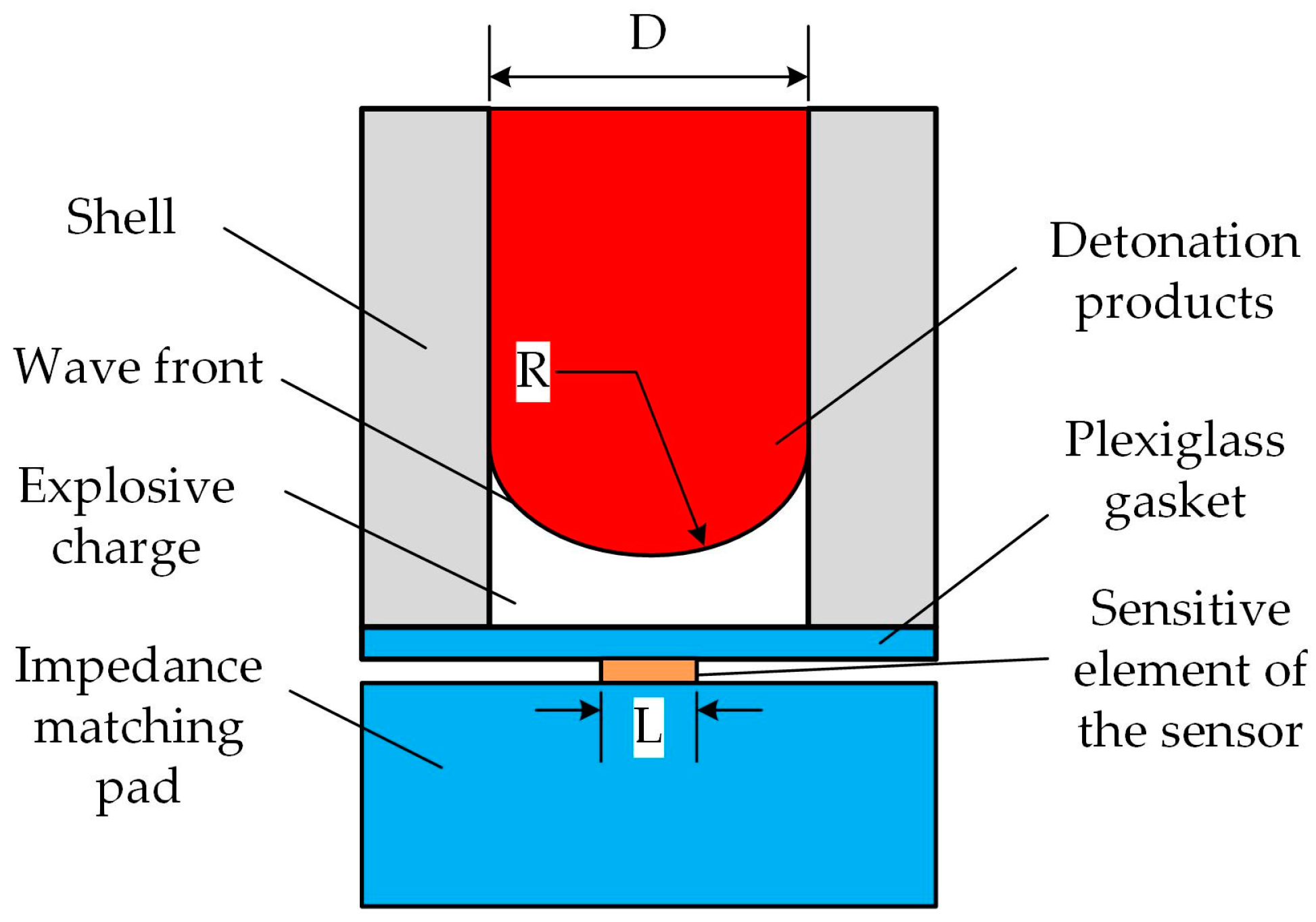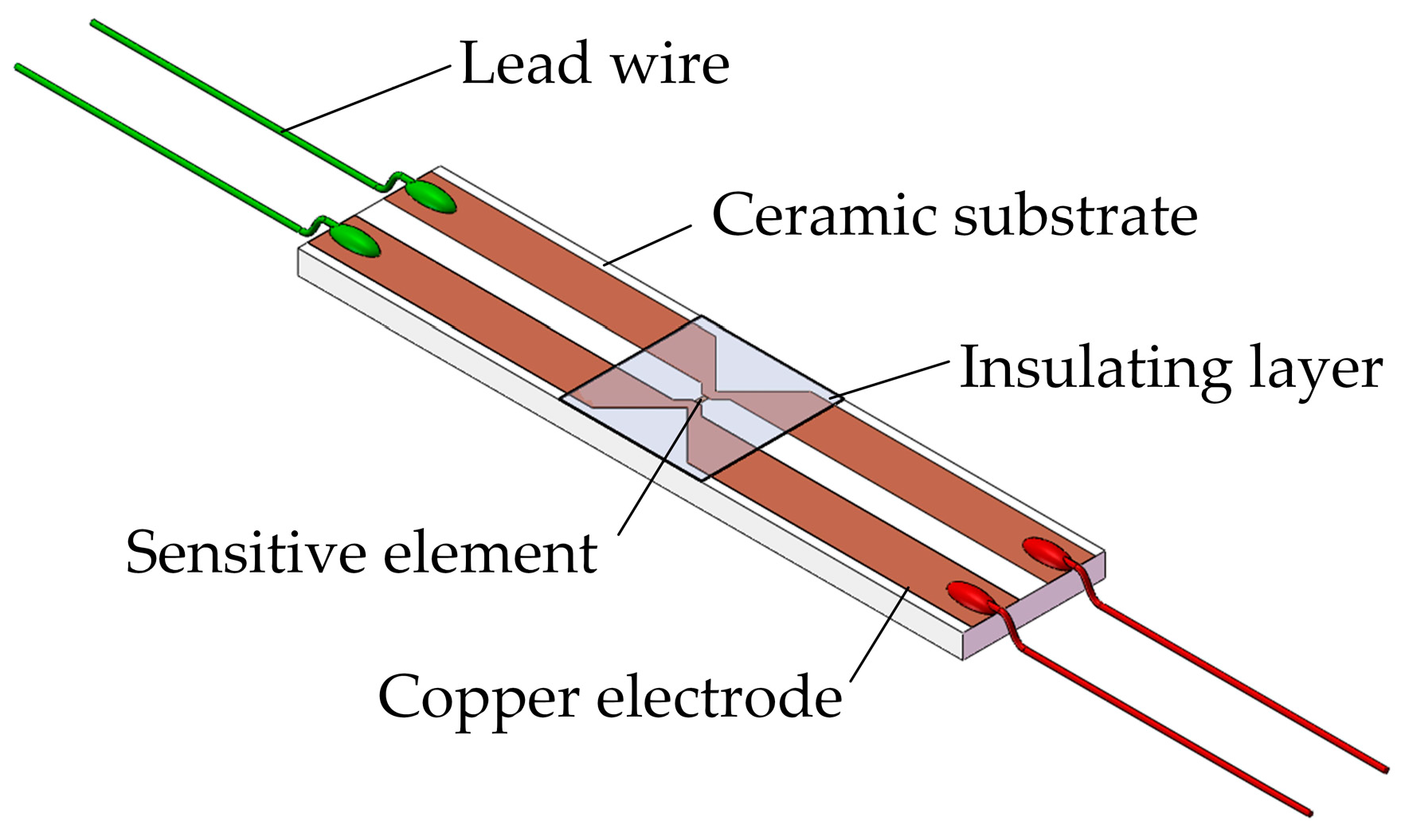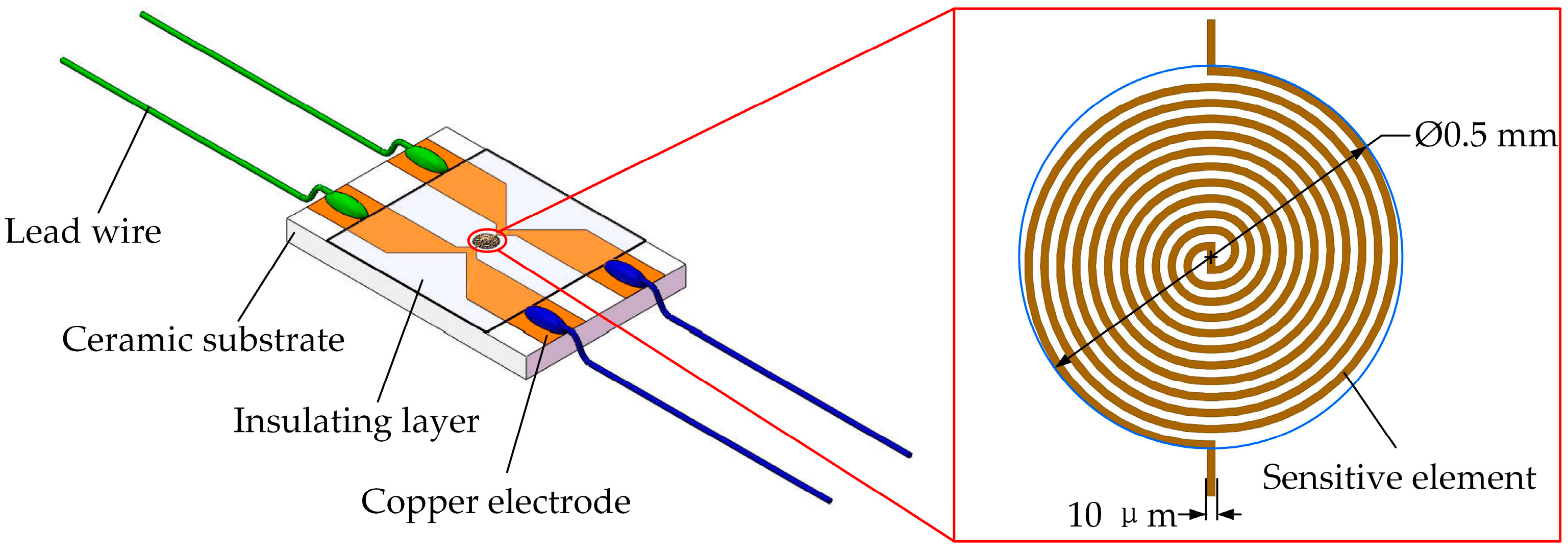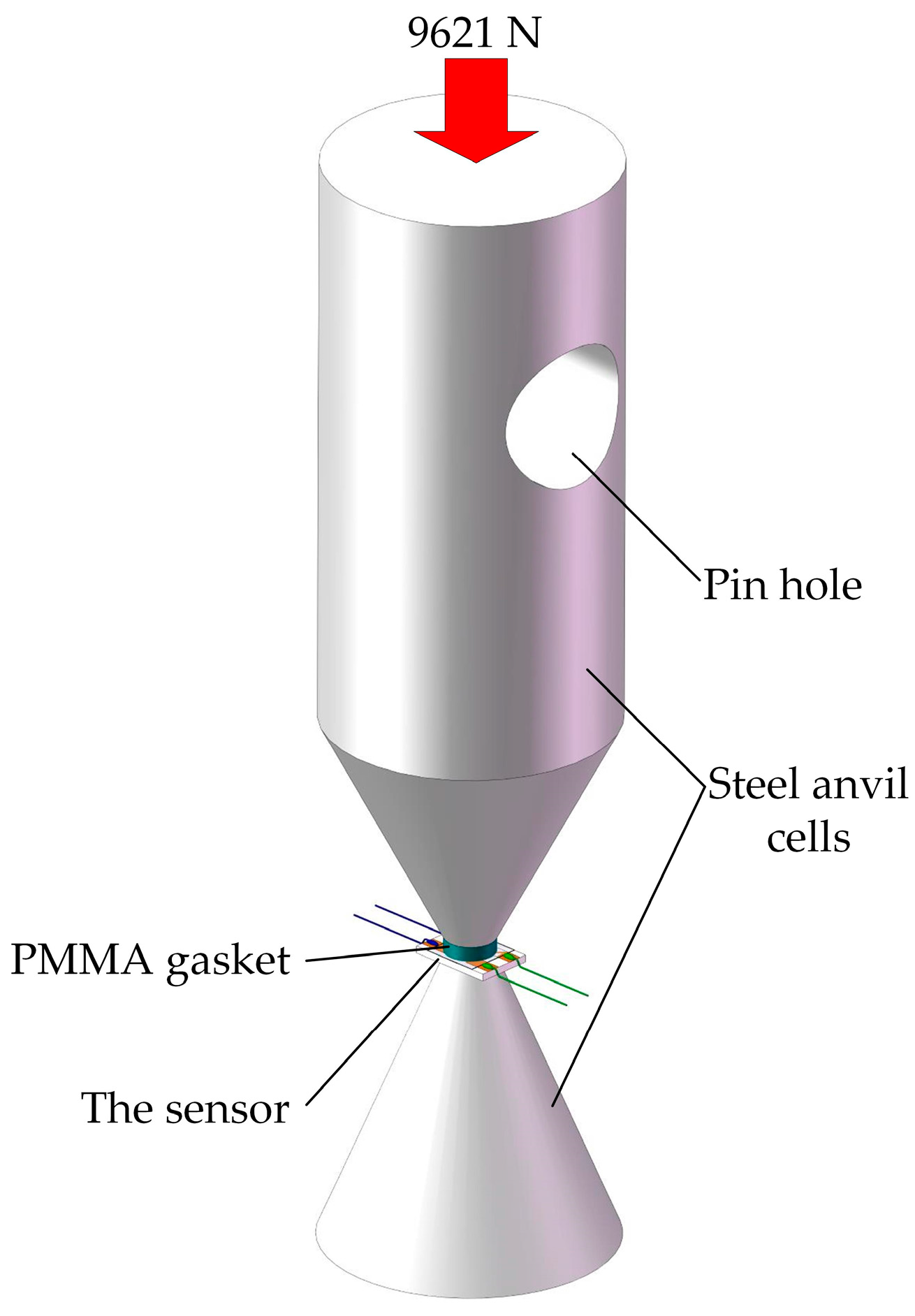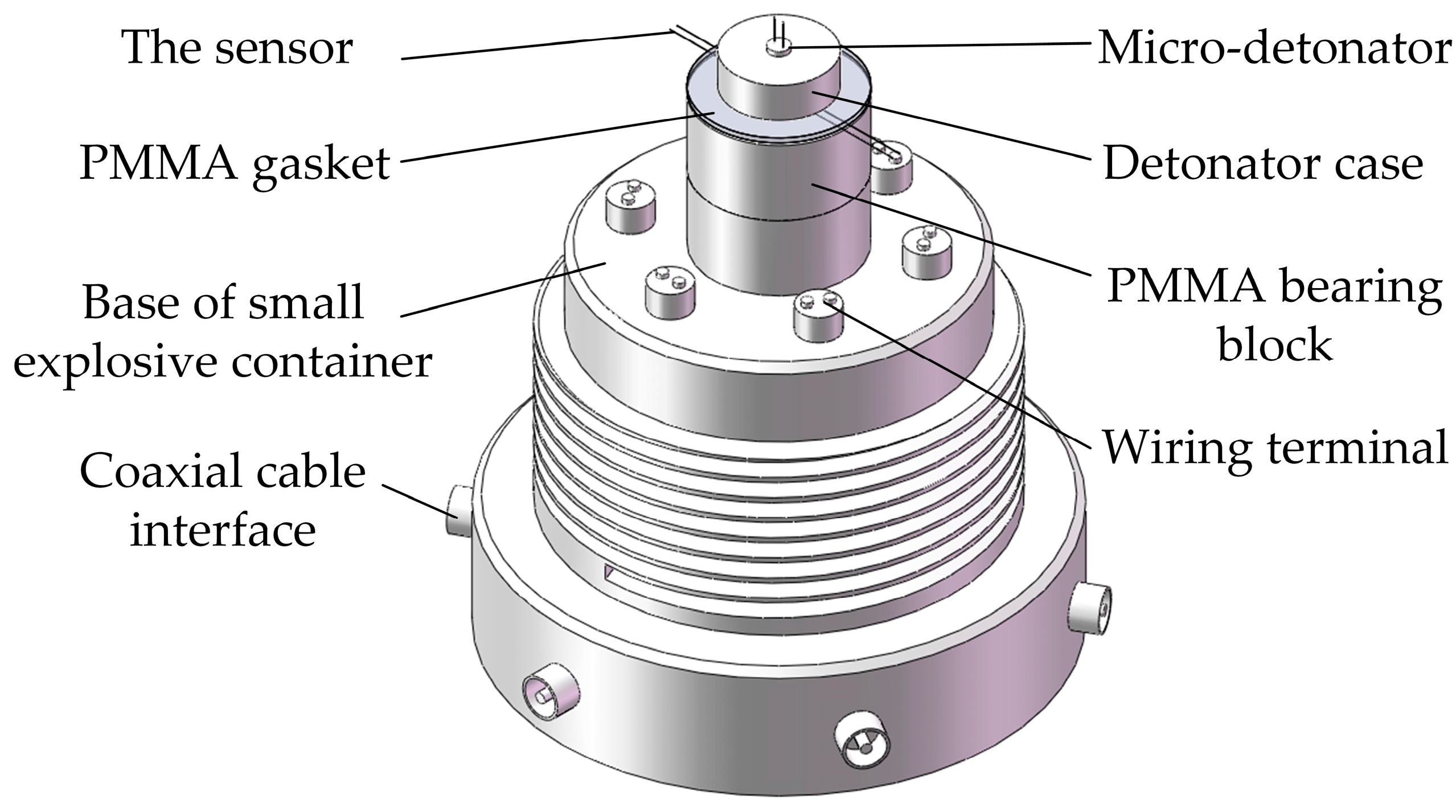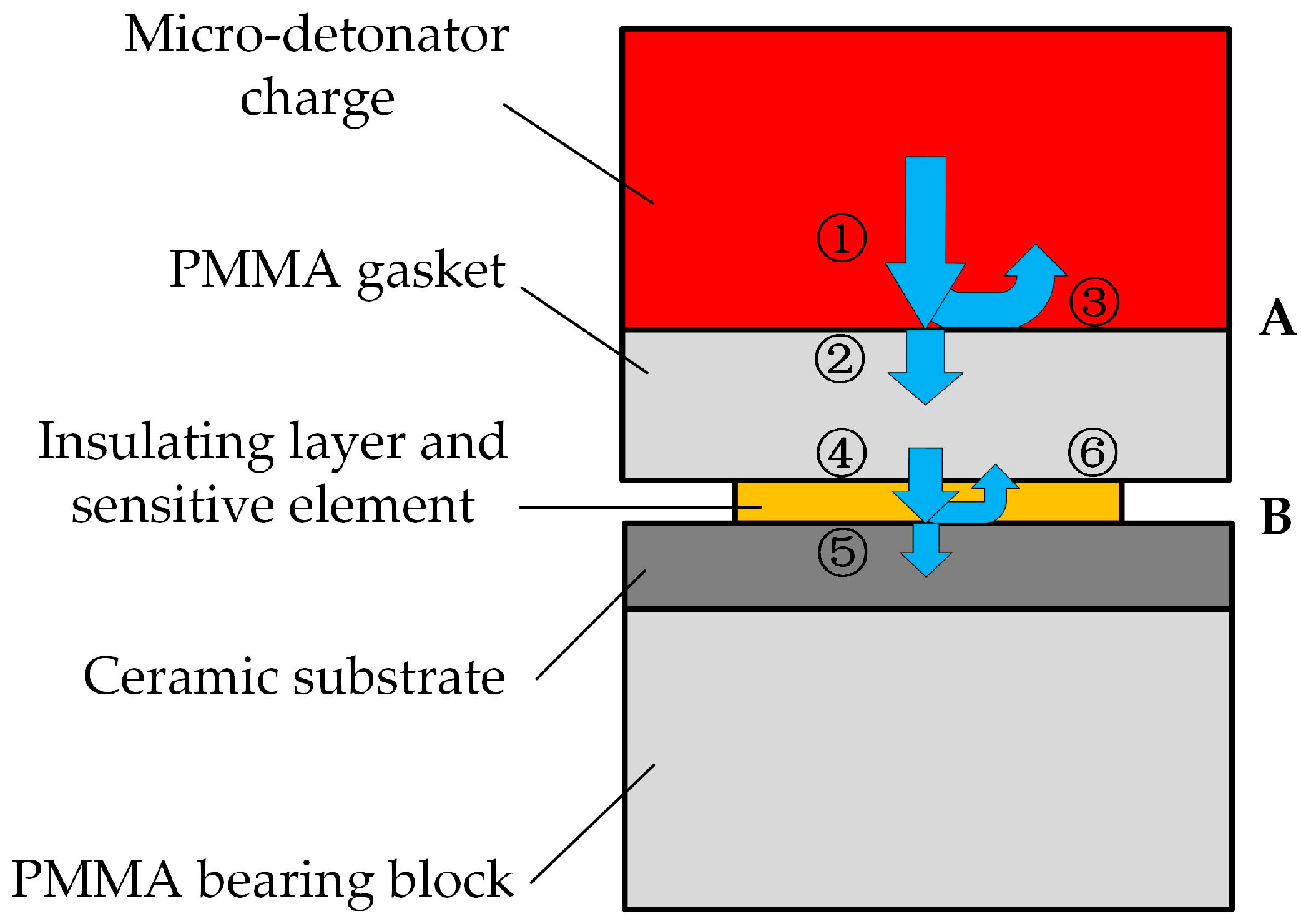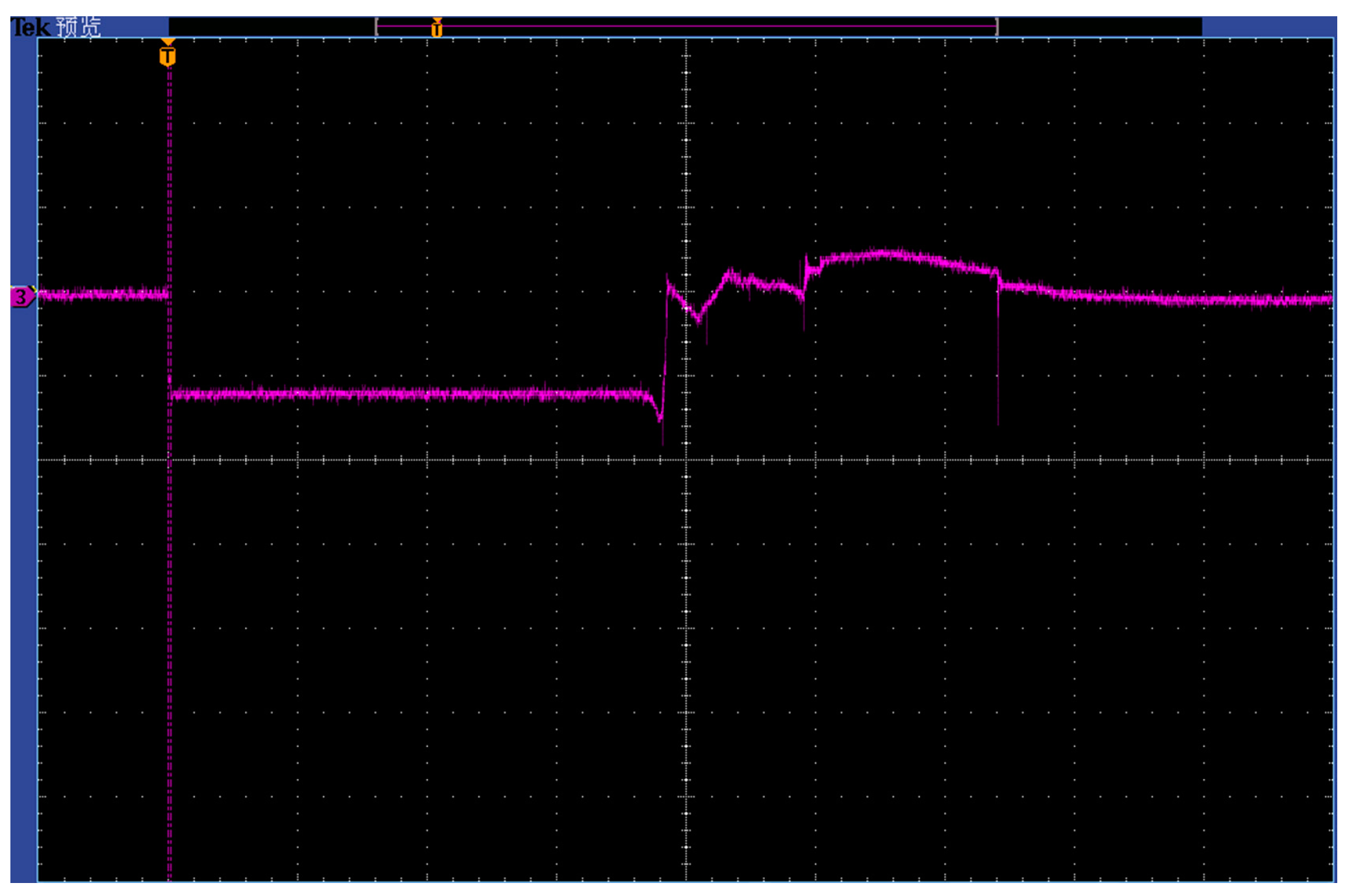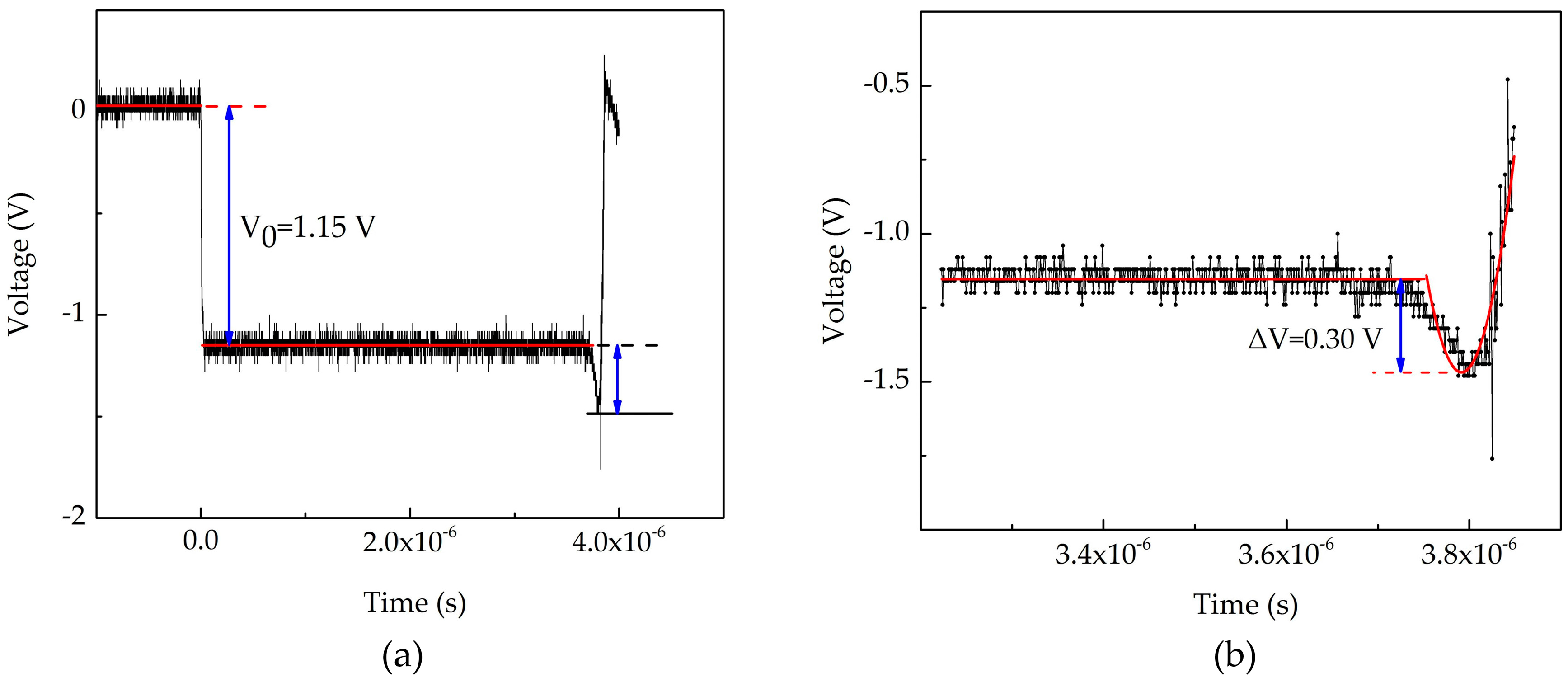2.1. Design Principle
The purpose of this study is to develop a manganin thin film ultra-high pressure sensor based on MEMS technology for measurement of the pressure explosively generated by EMs in microscale. Generally, the dimension of microscale charge is from 0.5 mm to 5 mm in diameter. In these cases, the bending effect of detonation wave fronts is enhanced, thus making detonation wave fronts become two-dimensional convex spherical ones. Specifically, as shown in
Figure 1, the pressure on the wave front is maximum at the center, and it attenuates along the radial direction and has an axial symmetry distribution. If the size of the sensor’s sensitive element is much smaller than the radius of curvature of the wave front, this shock wave is similar to a plane wave for the sensitive element, which is relatively ideal for the measurement. In practice, the following empirical formula generally needs to be met [
14]:
where
L is structure size of the sensitive element,
R denotes the radius of curvature of the wave front. For most condensed explosives, the maximum radius of curvature of the detonation wave is about 2~3.5 times the diameter of the charge [
17]. Then, we can derive the following inequation:
where
D is the diameter of the charge. In order to design the sensitive element expediently, we take the form
For example, if we want to measure accurately the detonation pressure of the charge with 3 mm in diameter, the structure size of the sensitive element must not exceed 1.2 mm.
However, the proportional relationship between maximum radius of curvature of the detonation wave and diameter of the charge is uncertain for different condensed explosives, especially the new explosive. In addition, for the measurement of pressure at the center of detonation, the smaller size of the sensitive element is better. But a lower limit of the dimension of the sensitive element is decided by processing conditions. Therefore, it is not reasonable that we choose the upper size of the sensitive element derived from Equation (3). In order to ensure the reliability and accuracy of the measurement, we propose a parameter called reliable coefficient which can be determine by processing conditions and experiences. In Equation (3) can be recast into the following equality because of the reliable coefficient
where
k is reliable coefficient within the range from 0 to 1. That is to say, Inequation (1) is a recognized empirical criterion for designing sensitive elements, and reliable coefficient reflects the designer’s influence factors on the design of sensitive elements. We give a definite design criterion by combining these two aspects, as shown in Equation (4). Given that
k = 1/6 based on our processing conditions in this study, we obtain that the maximum size of the sensitive element is 0.2 mm which is ideal for measuring accurately the detonation pressure of the charge with diameter of 3 mm or more.
Generally, detonation pressure of microscale charge is approximately ten GPa. In such condition, the sensitive element adopts a low resistance for three reasons [
16]: first, it is not necessary to use high resistance under high pressure; second, a low resistance can effectively reduce the area of the sensitive element to adapt microscale measurement; third, the piezoresistive effect of four leads can be ignored if the resistance of the sensitive element is much smaller than the characteristic impedance of transmission cables. In present paper, we set the resistance of the sensitive element equal to 0.5 Ω. If the resistivity of plating manganin is 50 μΩ∙cm [
18] and the length of the sensitive element is 0.2 mm, then we have the following equation:
where
w and
h are width and thickness of the sensitive element, respectively. If
h = 2 μm, we can derive that
w = 0.1 mm.
In a word, in order to measure accurately the detonation pressure of the charge with diameter of 3 mm or more, we designed a sensitive element with 0.2 mm long, 0.1 mm wide and 2 μm thickness in theory.
2.2. Sensor Design and Fabrication
A manganin thin film ultra-high pressure sensor based on MEMS technology for measuring the detonation pressure of microscale charge was designed as depicted in
Figure 2. The sensor employs a sandwich structure: 96% alumina ceramics of 0.5 mm in thickness was used as the substrate because of its good adhesion with manganin thin film, chemical corrosion resistance and excellent electrical insulation under high pressure; the sensitive element was made of manganin alloy with a straight strip type, two copper electrodes were extracted at each end of the sensitive element; the insulating layer adopted polyimide of 25 μm in thickness whose impedance matches with that of explosives [
19].
In order to realize the miniaturization of the sensitive element, MEMS technology was employed. Specific fabrication process is illustrated in
Figure 3: (1) photoresist was coated on the clean substrate by using a coater; (2) the pattern of the sensitive element on the mask plate was transferred to the substrate by lithography and development; (3) the manganin sensitive element was formed by magnetron sputtering, and then the heat treatment of 300 ℃ for one hour was carried out to increase piezoresistance coefficient of the manganin sensitive element; (4)−(6) the same procedures were implemented to form copper electrodes; (7) the polyimide was affixed to the sensitive element; (8) the lead wires were welded to the ends of four copper electrodes. The physical diagram of the sensor is shown in
Figure 4.
A standard four-probe method was applied to reduce the influence of lead resistance and contact resistance and to improve signal-to-noise-ratio (SNR) of the sensor. Two lead wires with the same color were connected with constant current source as the input terminal, the others were attached to the oscilloscope as the output.
2.3. Piezoresistance Coefficient of the Sensor
Manganin has been extensively studied in the last few decades. Many researches indicate that there is an empirical relation between resistance change of manganin and stress [
20],
where Δ
R is the resistance change,
R0 is the initial resistance,
P is the stress component in the shock direction and
Kp denotes piezoresistance coefficient that is a function of material composition and installation conditions [
16]. In general, the static piezoresistance coefficient will not have the same value as the dynamic piezoresistance coefficient for the same material. In addition, the dynamic piezoresistance coefficients obtained in different experimental arrangements may not agree, depending on the time duration of the measurement in relation to the shock equilibrium time across the specimens’ dimensions [
9]. Therefore, in order to obtain more accurate measurement results, the manganin sensor needs dynamic calibration in the same experimental arrangements as the practical applications.
However, calibration of the manganin sensor through shock experiments is a costly procedure. It would be advantageous if
Kp could be obtained from static high-pressure experiments. Rosenberg [
21] has shown that if the ratio of thickness to diameter for a thin layer is less than 0.5% one can consider the layer as though it were subjected to purely uniaxial strain. This strain state also exists in shocked specimens undergoing planer shock loading. Under this circumstance, the static and dynamic calibration curves agree within 2%. In this study, the accuracy of the sensor is designed to be approximately 4%. According to the above design principle, it can be considered that the sensitive element is subjected to one-dimensional shock wave. Therefore, the steel anvil cells configuration with a manganin thin film (aspect ratio of 0.5% or less) can be used as the static analog to the uniaxial strain dynamic experiments.
It can be seen from Equation (6) that piezoresistance coefficient is relative change rate of resistance of the sensitive element under pressure. In order to obtain well measurable resistance changes under small pressure, a larger initial resistance of the sensitive element is better. From the microcosmic viewpoint, the relative change rate of resistance of manganin is related to the Fermi energy of electrons and the spin of manganese ions [
9]. In other words, piezoresistance coefficients of the same batch of manganin sensitive elements are consistent in theory no matter what their shapes look like. Therefore, the spiral sensitive element manufactured by MEMS technology is employed to increase the resistance, as shown in
Figure 5. It is in a circle of 0.5 mm in diameter and has a minimum line width of 10 μm. Its thickness, which is identical with that of the same batch of sensors for dynamic measurement, is 2 μm. Then we can know that the aspect ratio of the spiral sensitive element is 0.4%. The resistance of the spiral sensitive element is determined by standard four-terminal resistance measurement technique. As shown in
Figure 6,
RAB,
RAC,
RCD and
RBD were measured by using a digital multimeter (type FLUKE 8845A). Thus, we can figure out the resistance of the spiral sensitive element through the following equation:
The whole sensor for measuring piezoresistance coefficient has a size of about 6 × 4 × 0.5 mm
3. As
Figure 7 shows, it was inserted between two steel anvil cells using a 1 mm thick polymethyl methacrylate (PMMA) gasket to insulate the sensor from the steel anvil, which ensures the same installation conditions as dynamic test. An electro-mechanical universal testing machine, which could apply standard quasi-static force for a certain time, was used to compress the whole assembly. The top steel anvil cell and the electro-mechanical universal testing machine were installed together by a pin hole and a pin shaft. Given that the diameter of anvil face is 3.5 mm, we can know that a force of 9621 N applied to the top steel anvil cell corresponds to a pressure of 1 GPa acting on the sensitive element by dividing the force by the area of anvil face. The measurements of resistance changes were taken with a digital multimeter (type FLUKE 8845A). During the test, five sensors in the same batch were used for reducing the random errors. Their test results are listed in
Table 1. Then we can calculate that the piezoresistive coefficient of manganin thin film ultra-high pressure sensor fabricated in this study is 0.0125 GPa
−1 by substituting the average value in Equation (6).
2.4. Sensor Application in Dynamic Test
In this section, the sensor shown in
Figure 4 is applied to measure the detonation pressure exerted by micro-detonator with a charge diameter of 3.42 mm.
The dynamic testing system includes digital storage oscilloscope (type TDS-2014B), high speed synchronous pulse constant current source (type MH4E) and small explosive container, as illustrated in
Figure 8. In the small explosive container, as shown in
Figure 9, the PMMA bearing block was pasted on the base of small explosive container with cyanoacrylate glue; the sensor was inserted between the PMMA gasket and the PMMA bearing block using epoxy resin adhesive; the micro-detonator was placed above the PMMA gasket through the case; the center of PMMA bearing block, sensitive element of the sensor, PMMA gasket and micro-detonator were consciously aligned to ensure the measurement accuracy. The input end of the sensor was welded with a wiring terminal, and the corresponding coaxial cable interface was connected with constant current output terminal of the constant current source through a coaxial cable. The same method was used to attach the output end of the sensor to the digital storage oscilloscope. Similarly, the fuses of micro-detonator were linked to synchronous trigger terminal of the constant current source. The shell and base of small explosive container were in threaded connection.
In order to ensure the safety and reliability of the dynamic test, debugging the test system is necessary. First, make a short circuit of the fuses of micro-detonator and open the oscilloscope and constant current source for about ten minutes. Second, check whether the constant current source has a normal current output. Third, set up the transverse ordinate and the trigger level of the digital storage oscilloscope for ensuring that the voltage signals can be captured.
When the test system was in good condition, initiation circuit of micro-detonator was connected. Then, the synchronous trigger terminal of the constant current source triggered the detonator and the digital storage oscilloscope synchronously through coaxial cables. Constant current output terminal of the constant current source provided a constant current to the input end of the sensor. The output signals of the sensor were recorded in the oscilloscope. The detonation wave produced by micro-detonator exerted on the sensitive element, which caused the change of resistance of the sensitive element. Correspondingly, the voltage signals of the oscilloscope changed. We can calculate the detonation pressure by the relative change rate of the voltage.
